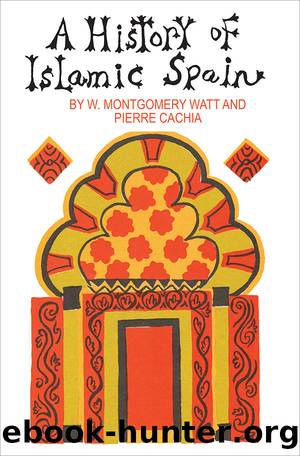A History of Islamic Spain by Pierre Cachia

Author:Pierre Cachia [Cachia, Pierre]
Language: eng
Format: epub
Tags: History, Europe, Spain & Portugal, Medieval, Religion, Islam, Social Science, Islamic Studies
ISBN: 9781412844710
Google: qTiG6DsJi7AC
Publisher: Transaction Publishers
Published: 1977-01-15T04:59:51+00:00
2. Spain under the Almohads (to 1223)
'Abd-al-Mumin: 1130-1163
Abū-Yaqūb Yūsuf i: 1163-1184
Abū-Yūsuf Ya'qūb al-Mansūr: 1184-1199
Muhammad an-NÄsir: 1199-1213
Abū-Ya'qūb Yūsuf 11: 1213-1223
The position of al-Andalus after the loss of control by the Almoravids in 1145, and still more after the Almohad capture of Marrakesh in 1147, is obscure. Effective power was in the hands of a number of petty local rulers. Some of these may for a time have continued to be, in some respects, dependent on the Christian kings, but more and more they tended to acknowledge the suzerainty of the Almohad caliph. The greatest measure of independence was shown by Ibn-Mardanish who ruled Seville and had some control over much of the west of al-Andalus.
The founder of the Almohad empire, 'Abd-al-Mumin, after incorporating Tunisia and Tripolitania, began to think once more of the Iberian peninsula and from 1162 was making preparations for a large-scale campaign there. Before the plans could come to fruition his death intervened, and the son who (after a short dispute) succeeded him, Abū-Ya'qūb Yūsuf, did not carry out these plans. It was not indeed until 1171 that the new caliph attempted to take a firmer grip of al-Andalus. There was opposition from Ibn-Mardanlsh, but his death in 1172 left his successors with little choice except to surrender Seville to the Almohads. The caliph proceeded northwards after this, and for a time besieged Toledo; but eventually he realised the great difficulty of the operation and his folly in prosecuting this enterprise, and therefore abandoned it. After this, however, the Almohads seem to have had effective control of most of al-Andalus. In a later campaign Abū-Ya'qūb Yūsuf was able to carry the "holy war" into the enemy's territory. Unfortunately he was wounded in besieging the fortress of Santarem (near Lisbon), and shortly afterwards died from his wound (1184).
The first task of his son and successor, Abū-Yūsuf Ya'qūb, was to recover the town of Bougie and the neighbouring part of the Algerian littoral from a descendant of the Almoravids who had set himself up there as an independent ruler. This series of events shows that, though the Almohads could bring together, when it was required, an extremely powerful army, the forces by which they maintained order in normal times were insufficient to restrain adventurers. There was usually thus some part of his empire which needed the special attention of the Almohad caliph. It was not until 1189 that Abū-Yūsuf Yaqūb was able to give attention of this kind to al-Andalus. Various successes enabled him to get the agreement of the kings of Castile and Leon to a five years' truce in 1190. After further operations against fortresses in Portugal in the same year and the following one, he was able to leave al-Andalus in a comparatively settled condition while he attended to urgent matters in Africa. The end of the truce led to a further period of activity in the Iberian peninsula. Early in the campaign in July 1195 the Almohads won a great victory over Alfonso VIII of Castile at Alarcos (about halfway between Cordova and Toledo).
Download
This site does not store any files on its server. We only index and link to content provided by other sites. Please contact the content providers to delete copyright contents if any and email us, we'll remove relevant links or contents immediately.
| Hadith | History |
| Law | Mecca |
| Muhammed | Quran |
| Rituals & Practice | Shi'ism |
| Sufism | Sunnism |
| Theology | Women in Islam |
The History of Jihad: From Muhammad to ISIS by Spencer Robert(2566)
Nine Parts of Desire by Geraldine Brooks(2325)
The Turkish Psychedelic Explosion by Daniel Spicer(2313)
The First Muslim The Story of Muhammad by Lesley Hazleton(2217)
The Essential Rumi by Coleman Barks(1987)
1453 by Roger Crowley(1956)
The Last Mughal by William Dalrymple(1829)
Trickster Travels: A Sixteenth-Century Muslim Between Worlds by Davis Natalie Zemon(1813)
God by Aslan Reza(1612)
Muhammad: His Life Based on the Earliest Sources by Martin Lings(1605)
by Christianity & Islam(1594)
A Concise History of Sunnis and Shi'is by John McHugo(1545)
Magic and Divination in Early Islam by Emilie Savage-Smith;(1498)
No God But God by Reza Aslan(1490)
The Flight of the Intellectuals by Berman Paul(1461)
Art of Betrayal by Gordon Corera(1399)
Nothing to Envy by Barbara Demick(1383)
What the Qur'an Meant by Garry Wills(1359)
Getting Jesus Right: How Muslims Get Jesus and Islam Wrong by James A Beverley & Craig A Evans(1307)
